Dahlias are arguably one of the most beautiful cut flowers to grow, whether you’re a beginner cut flower farmer or an experienced farmer florist. That being said, they can be one of the trickiest cut flowers to overwinter in cold climates, such as my Zone 3 garden in the Canadian Prairies.
If not stored properly, dahlia tubers can either rot or dry out, which will destroy your precious dahlias! And, let’s be real, Cafe au Lait and Peaches and Cream tubers are not cheap. You don’t want those babies to die on you! For context, this year (in 2022) Peaches and Cream tubers are currently running between $15-20 per tuber. That’s not for a clump… that is for a single tuber!
In this post, I’ll show you how to take care of your dahlias over winter, so they come back again next spring. And, if you want to see what dahlia tubers (and gladiolus corms) look like when they are properly overwintered, check out this video:
This post contains affiliate links, which means that if you purchase something, I earn a small commission at no extra cost to you. You can read more about it in my privacy policy. Thanks for supporting Shifting Roots!
Can’t I just keep my dahlias in the Ground over Winter?
If you live in a climate with a short growing season and your first frost happens by October, the advice I am going to give should work and you can follow it. If you are in a climate that is really moist and your frost doesn’t happen until at least December, you’re going to want to pull your tubers earlier than this advice says. If you leave them in the ground until your first frost in December, your tubers have a much higher chance of rotting out.
In either climate, there is no rule that says you can’t start digging your tubers out before your first frost. Because let’s face it, if you’re a serious flower farmer you might have 600 dahlia tubers to dig up. That size job will take you a week or more. In my city garden with approximately 24 tubers, I could dig everything out in an afternoon. Even at that small of a number, though, I would still allow myself anywhere from between 2-4 hours.
Unless you live in Zone 8 or higher, you can not keep dahlia tubers in the ground over winter. If you do, they will rot and become compost. In fact, you must dig them out before the first hard frost, and it’s better if you can get them out shortly after the first light frost.
Dahlias need to be stored in the darkness in a heated garage or cool (but not freezing!) basement. You’ll also need a container to store them in, such as a flat cardboard box or large plastic container.

Related: Why Are My Dahlias Not Blooming?!
Label Dahlias before the First Frost
Once there is a risk of frost in the forecast, label the plants by tying survey tape or some other label around the very bottom of the stem. You need to do this step before the first frost so you can see every dahlia and know what it is. Unless you have a large flower farm where every section is already labelled, you will not remember which dahlia is which once the frost hits and they are all shrivelled up.
Take note of what height the dahlias are, as well, if you have a large number that are of varying heights.

Related: How to Get More Dahlias for Free with Cuttings
WHAT TO DO AFTER YOUR DAHLIA PLANTS DIE
Once a frost has hit, trim off the stems, leaving 10 cm/4 inches or a bit less. Dig out the dahlias with a shovel, brush off the dirt, and let them dry for a day or two. Let them dry in a spot that gets no direct sun or frost.
While the typical wisdom says to remove dahlias after the first frost , the weather in Saskatchewan and other cold climates is not always typical. You should always use your best judgment. There are even years that we’ve had surprise -30°C temperatures in October.
Some of the confusion about when to do things lies in the fact that the green part of the dahlia plant cannot handle any frost whatsoever. They will die. On the other hand, your tubers in the soil can survive up to harder frosts of up to -5°C/23°F C provided you haven’t had smaller frosts along the way.
Even if they are still connected to one another, the tuber will survive and the flower and stem will die. Your dahlia tubers will start to rot, however, if your soil temperature gets too cold.
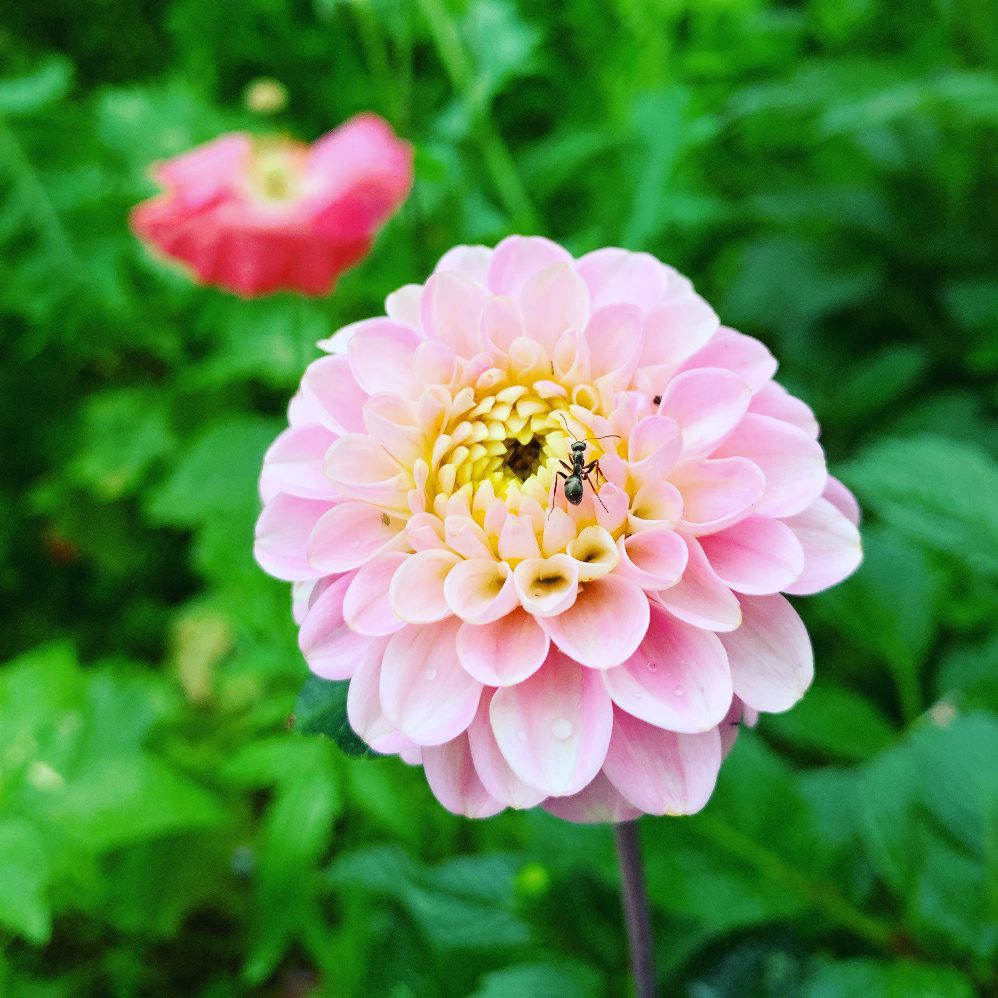
How cold is too cold?
There’s no simple answer to this question, but dahlia tubers can survive a frost or two if the ground is still warm. I’d start to get worried if my dahlia tubers were exposed to multiple nights of -4°C to -10°C outdoors. Remember: a frozen dahlia tuber is a dead dahlia tuber. Use your best judgment and err on the side of caution. If you wait until the ground is frozen to dig up your tubers, you’ll be out of luck.
THREE METHODS TO STORE DAHLIA TUBERS
How to be succesful in dahlia tuber storage depends most on the climate you live in and whether you have access to a dark cool location (between 3 to 10°C) where you can keep the tubers over winter. For example, storing my tubers in peat moss and plastic bags with a little bit of ventiliation works very well for me, yet a flower farmer I know over in Alberta (one province over with a similar climate) finds if she does it that way all her tubers die. She swears by vermiculate and plastic.
This is why I have in the past suggested getting very cheap tubers the first year so you can expeirment with the diferent methods and figure out what actually works for you. Even then, it is normal to lose 10-25% of your tubers .
Here are my three methods for storing dahlias so they can survive the winter in your basement. No method is better than another, so pick one that you feel is most convenient for you:
- Wrap your dahlia tubers in plastic. Place clean and labelled dahlias in a plastic grocery bag or black garbage bag. Do not tie the bag shut, as you still want there to be some airflow. Place the bag in a cardboard box, making sure that the dahlias stay dark.
- Place the dahlias in a container with barely moist (but not wet!) peat moss, growing mix, vermiculite, or a combination of all three. It doesn’t matter which one you choose. Cover loosely with a black plastic bag to keep it dark.
- Are your dahlias in containers? You can just trim the stem, cover the dahlia loosely so it is dark and there is still airflow, and store the whole container in the basement. You could also store it in an attached garage as long as the temperature doesn’t go below freezing.

Related: How to Grow Dahlias in a Short Growing Season and Cold Climate
CHECK YOUR DAHLIA TUBERS Occasionally
Caring for dahlias over the winter is not a set-it-and-forget-it proposition. Check your dahlia tubers 2-3 times over the winter, and if you start to notice that they’re getting mushy, throw them out. If you notice that they’re starting to lose their plumpness and drying out, your location is too warm. If you can’t get them colder–modern houses just don’t seem to have proper cold storage–you can put them in soil under a grow light and try to wake them up early in February, January, or whenever it is that you notice. Ideally, your dahlia tubers should remain plump throughout the winter.
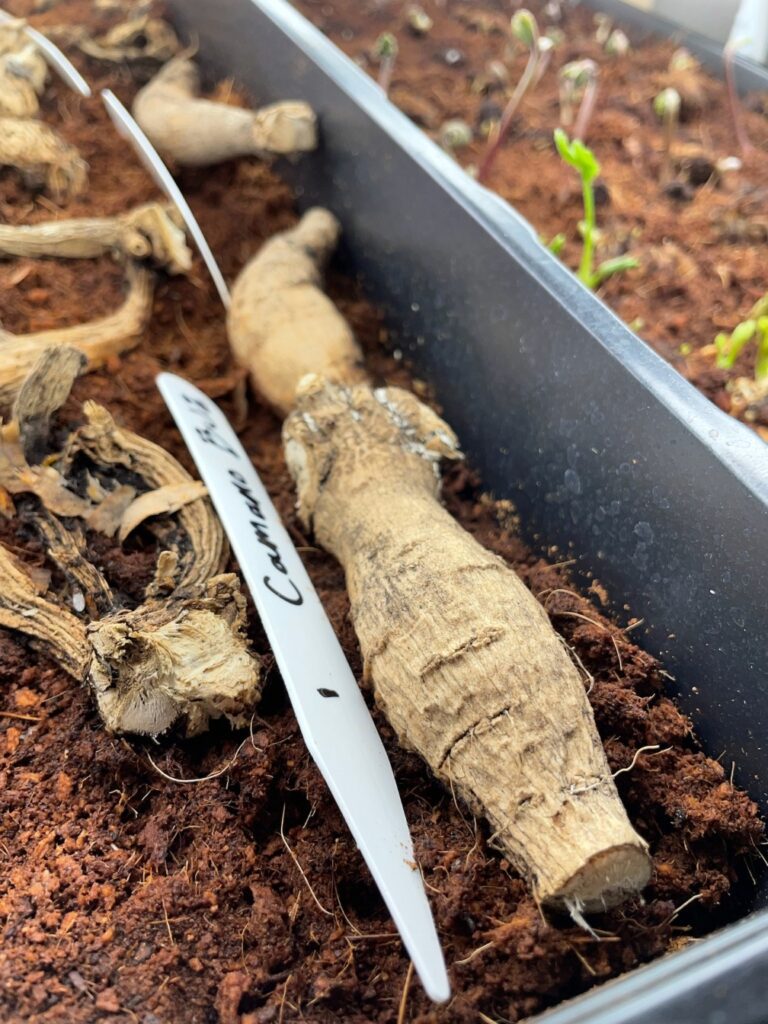
Related: Swoon-worthy Dahlia Varieties for your Cut Flower Garden
The key to preserving dahlia tubers over Winter: Darkness and Slight Moisture
Dahlias are a bit of a diva when it comes to winter storage. They need utter darkness, and conditions that are moist, but not watery. The best way to achieve this is to mist them with water before storing them, and then to mist them again every month or two if they look like they’re starting to dry out.
Don’t set your boxes of dahlias directly on a cement floor. The cement will steal the moisture and dry them out.
If your dahlia tubers dry out over the winter, you can try to revive them by soaking them for an hour or two in a bowl of water or giving them a generous misting. I’ve heard varying results on the internet about whether this works or not, but it’s worth a try.
You can also just try and plant the dried-out tuber directly into the ground in spring. You might get lucky and it will grow.
UPDATE: I recently had a set of almost dried-out tubers that I put under grow lights and misted daily. A month later, I was able to salvage only some of them. Those tubers did wake up and become productive tubers. The thinner tubers, however, were not salvageable and never did anything.

Get a head start on Your Dahlia Flowers in Spring
The following instructions are best suited to my Zone 3 climate in Saskatchewan, Canada, but can easily be adapted for Zones 2-5. I’m assuming a last frost date of approximately May 21st.
When you live in a place with a short growing season (90-100 days) you need to get a head start on growing your dahlias. Dahlias typically bloom from mid-to-late August through September. If you get your tubers in late and there’s an early frost, you might not even get any blooms.
I bring my dahlias out from storage in mid to late April, mist them with water if they need it, and put them under a grow light or on a window ledge. A south-facing window is best, but an east or west-facing window will also do. Most tubers start to get green shoots in about a week or so.
If you have tubers that don’t get any green bits, don’t worry. You can still plant them and they will still grow once you put them outside. I would also try planting any tuber that looks dried up on the off chance that they’ll survive. Don’t plant any tubers that have gone mouldy.
Once all risk of frost has passed, take your tubers out to the garden and plant them. You’ll be rewarded with beautiful dahlias at the end of the season.
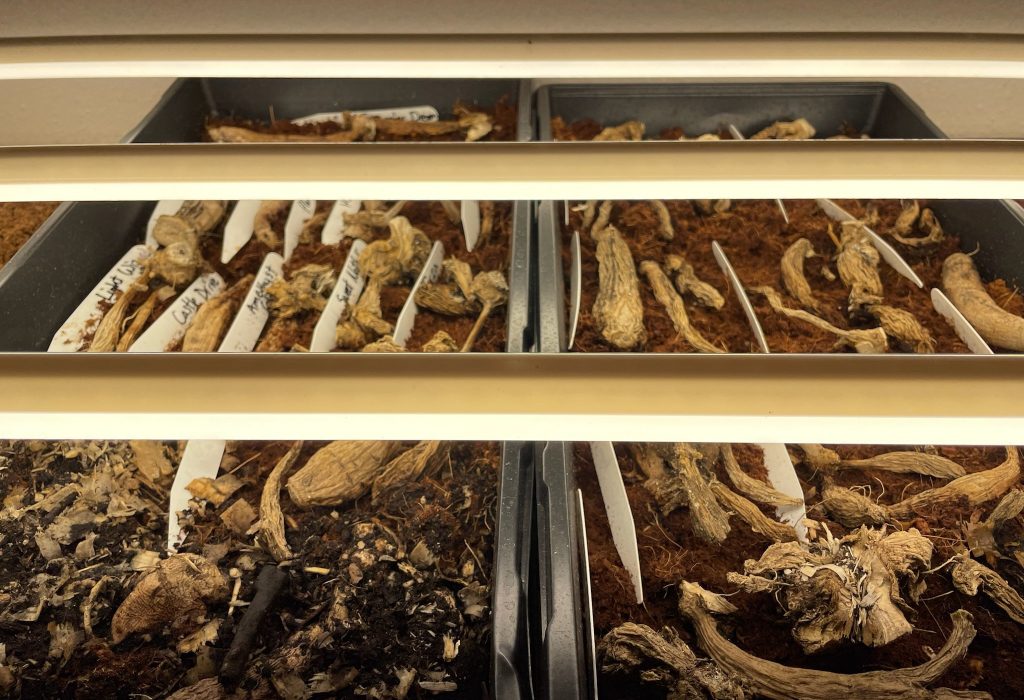
SHOULD YOU SEPARATE YOUR DAHLIA TUBERS IN THE FALL OR IN THE SPRING?
I personally find that leaving my dahlia tubers in clumps over the winter gives me more success and a better chance of them surviving. I also am not super confident with splitting tubers and like to see where the eyes are before I do it. Seeing the green shoots always reassures me that I am doing it correctly. You can split them in the fall, and for some people this works better, so give it a shot if you like! It’s kind of like the rest of it, though. It’s a crap shoot, and you can’t know until you try.

MORE RESOURCES ON DAHLIAS
Connie’s Dahlias: A Beginner’s Guide
This book is by Connie Thompson, out of British Columbia. She’s been growing dahlias for years and years and in Canadian growing groups she is the authority on dahlias and dahlia tubers.
Floret Farm’s Discovering Dahlias: A Guide to Growing and Arranging Magnificent Blooms
This one is a better buy for those who share a similar climate to Floret, but even if you don’t it’s the prettiest book to look at. This book will make you fall in love with dahlias. You’ll want to buy every single dahlia variety in the book, so read at your own risk!
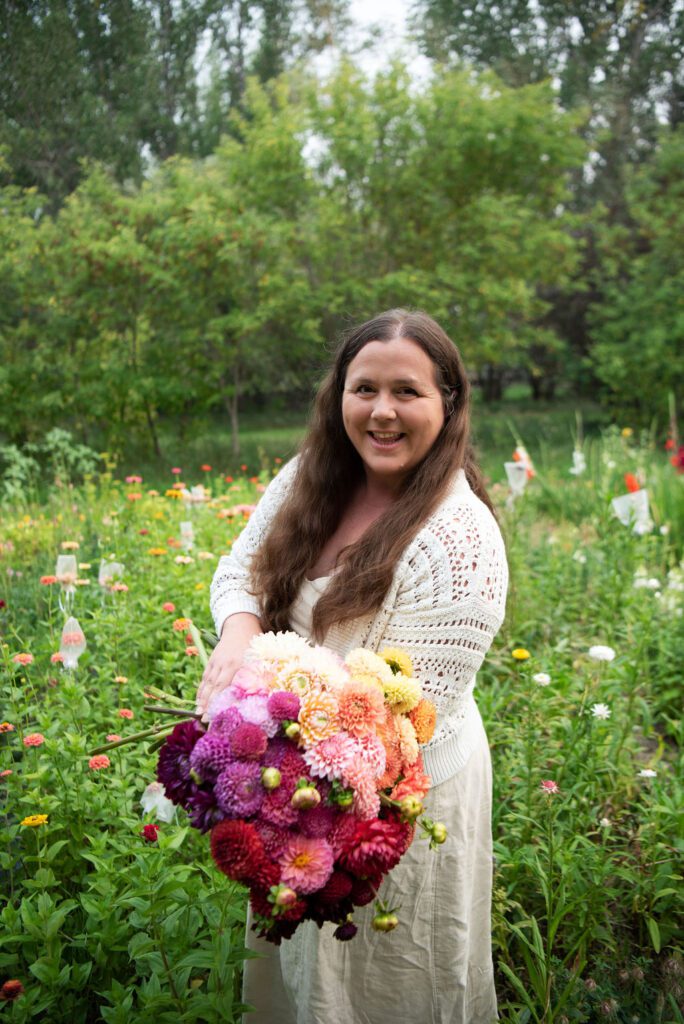
Planting and overwintering dahlias is a bit of extra work, but the gorgeous blooms are well worth the effort. I hope these tips help you in your own cut flower garden! What do you think, will you grow dahlias this year?
If you liked this blog post, follow me on Facebook, TikTok, and Instagram for more cold-climate gardening tips, delicious recipes, and cut flower goodness! I also make weekly videos over on my YouTube channel. I hope to see you there!
P.S. If you love the content I create for Shifting Roots, consider joining our community on Patreon. Your support means the world to me and I am grateful for each and every one of you!
Ready to grow your own beautiful cut flower garden, without the hassle?
I’ve taken all the guesswork out of creating a cut flower garden with my e-book, Cut Flowers Made Simple. Whether you’re a farmer florist, beginner gardener, or anything in between, you’ll be able to start your own cut flower garden–with or without seed starting–growing annual flowers!


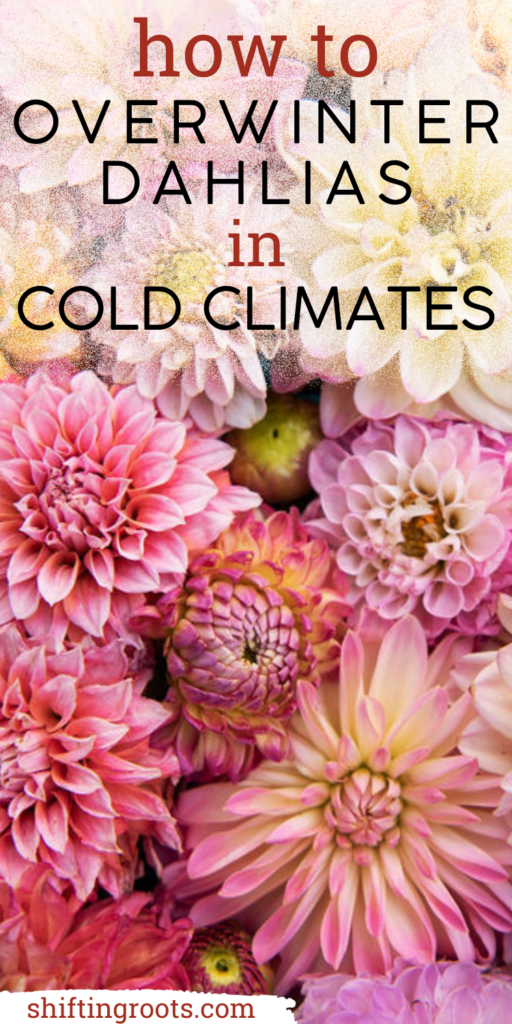

Jackie
Kristen Raney
Janice Penner
Kristen Raney
Lynn
Kristen Raney
Darlena
Kristen Raney
Nadine Hiebert
Lucille Capuano
Liz
Mike Boehm
Anne Sikkema
Jane Walsh
Kate Schutz
Tracy
Mary Dionisio
Mark Caplin
Becky
Vickie Gierke
Lois Aitken
Melanie
Fred Maurer
Kristen Raney
Janis
Judy